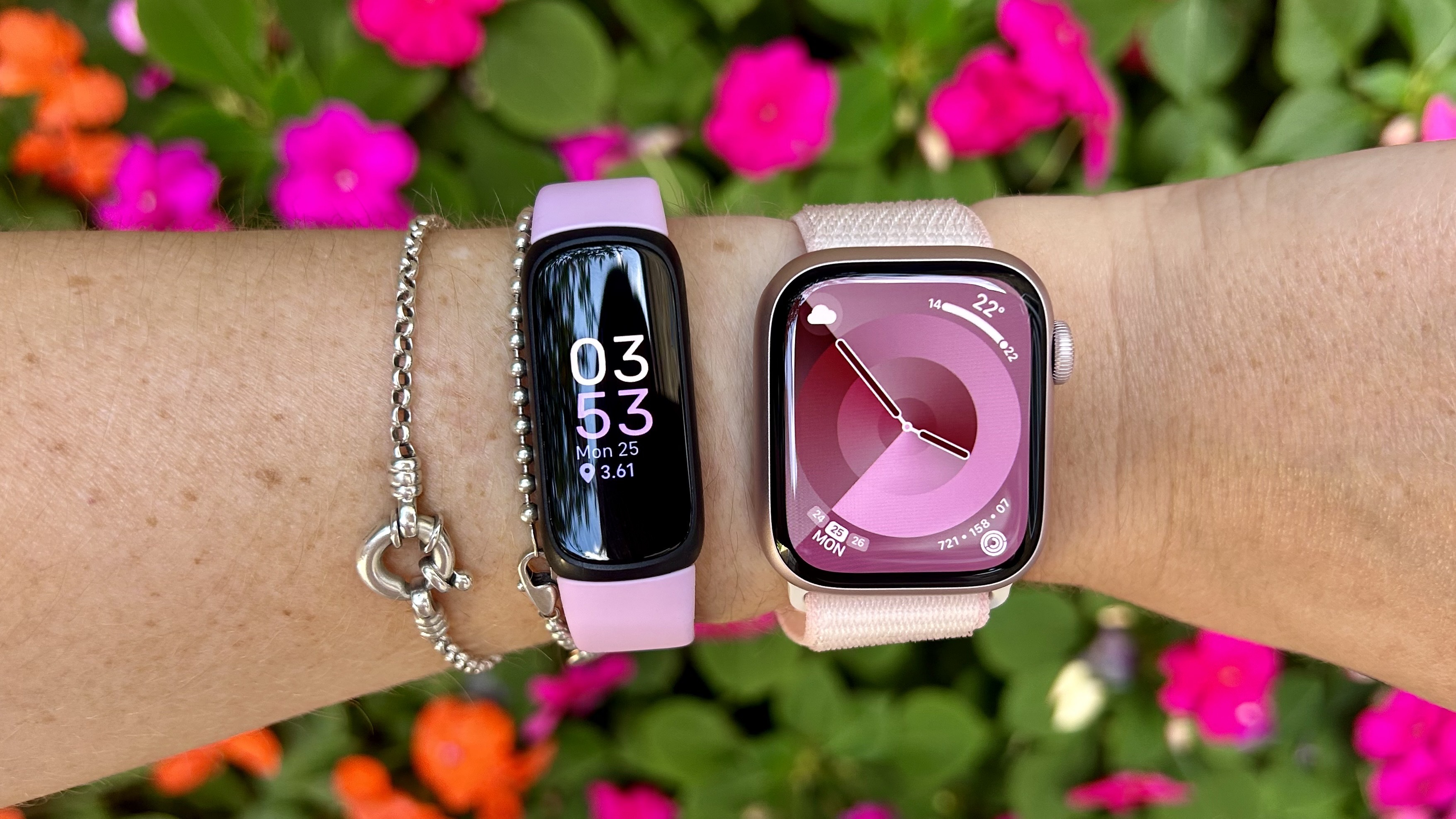I walked more than 10,000 steps with the Apple Watch Series 9 and the Fitbit Inspire 3 — and one was way more accurate
Here's which tracker won

Ever wondered whether Apple or Fitbit is more accurate when it comes to counting your steps? So did we. To find out more, I strapped one of the most popular Fitbits on the market — the Fitbit Inspire 3, and the brand new Apple Watch Series 9 to my wrist, and set out for a long-ish walk, manually counting my steps as I went.
On my first walk, I did 8,000 steps and found that one fitness tracker was more accurate than the other. To check it wasn't just a fluke, I went back out for another walk of 2,000 steps, and below, I've rounded up the results. Get ready to be surprised.
Before we get into the results, let’s start by taking a look at how the two fitness trackers record your steps taken. Both the Apple Watch Series 9 and the Fitbit Inspire 3 count your steps in a similar way — using an internal accelerometer, which measures the swing of your arm. Each swing counts for two steps. It doesn’t matter whether you wear your watch on your dominant or non-dominant hand, or whether you’re walking with your hands in your pockets, or holding something, the accelerometer should still measure your body’s movement.
Fans of the Tom’s Guide fitness pages will know this isn’t my first step-counting experiment. You can read what happened when I walked 6,000 steps with the Apple Watch Series 8 and the Fitbit Inspire 3 here.
I walked 10,000 steps with the Apple Watch Series 9 and the Fitbit Inspire 3 — here’s which was more accurate
Of course, it’s important to point out here that there are some huge differences between the Fitbit Inspire 3 and the Apple Watch Series 9, and it’s unlikely you’d ever really be comparing the two. The Apple Watch Series 9 is one of the best smartwatches on the market, and is far more advanced than the $99/£84.99 Inspire 3. Unlike some of the other best Fitbits, the Inspire 3 doesn’t have built-in GPS, but it’s one of the best cheap fitness trackers for good reason — you’re getting an awful lot for your money, and it has a beautiful, bright screen. Check out our Fitbit Inspire 3 review to find out more.
The Apple Watch Series 9, on the other hand, is the best smartwatch on the market, featuring Apple’s new S9 processor. The watch will set you back $399 / £419, and has a number of advanced smartwatch features you won’t find on the Fitbit, as well as built-in GPS, and advanced sports tracking profiles. Read our Apple Watch Series 9 review here to find out more.
But putting this aside, in order to test the accuracy of both watches, I strapped them both to my wrist and manually counted 8,000 steps. To avoid losing count as I walked, I used a $6.99 tally counter tool from Amazon and clicked each time I took a step. When I got home, I compared the data from the two watches.
Get instant access to breaking news, the hottest reviews, great deals and helpful tips.
On my first walk, my Apple Watch Series 9 recorded a walk of 3.79 miles in one hour and seven minutes. The Fitbit Inspire 3 recorded a walk of 3.26 miles in one hour and seven minutes — it’s worth noting the distance here, which is half a mile shorter. This is pretty significant, but is probably down to the fact the cheaper tracker does not have built-in GPS, so was relying on my phone signal, which definitely drops on parts of my daily walk. Both the Apple Watch Series 9 and the Fitbit Inspire 3 said I had an average heart rate of 97 beats per minute (bpm).
On the second walk, my Apple Watch Series 9 recorded a walk of 0.96 miles in 20 minutes and 18 seconds. The Fitbit Inspire 3 recorded a walk of 0.86 miles in 17 minutes, 17 seconds. Again, it's worth highlighting that without built-in GPS, the walk is shorter.
In order to compare steps, I uploaded both walks onto my phone and used Fitbit’s app to look at my overall steps and Active Zone Minutes. I’ve learned in the past that Apple makes it nearly impossible to view your exact amount of steps per workout. Sure, you can see your daily total in the Fitness app, and you can find hourly step data in the Health app, but to make things a little less confusing, I downloaded the StepsApp Pedometer app on my Apple Watch.
The results
Walk one
- Manual recording: 8,000 steps
- Apple Watch Series 9: 7,730
- Fitbit Inspire 3: 7,660
Walk two
- Manual recording: 2,100 steps
- Apple Watch Series 9: 2,048 steps
- Fitbit Inspire 3: 2,096 steps
As you can see from the results, things are a little mixed. The Apple Watch Series 9 was closer to my manual recording on the first walk, and therefore, more accurate than the Fitbit Inspire 3 on that test. On the second test, the Fitbit Inspire 3 only missed four steps, whereas the Apple Watch Series 9 missed 52 steps.
It’s worth noting that no fitness tracker will be 100% accurate at counting every single step — I’m five foot two, and have quite a short stride. When I’m running, I often find I have a high cadence because of this. What’s more, fitness trackers do a lot more than just tracking your steps, and counting steps alone isn’t the best metric when it comes to getting fitter and losing weight. That said, it’s a good place to start.
Although the 10,000 steps per day message started as a marketing campaign, a review of 32 studies, published in the International Journal of Behavioral Nutrition and Physical Activity found that “10,000 steps/day is a reasonable target for healthy adults.”
10,000 steps is the equivalent of walking around 5 miles per day, which might sound like a lot, but might mean taking the stairs, not the elevator, getting off the subway a couple of stops early, or meeting a friend for a walk at lunch, not sitting in a coffee shop. There are a number of benefits of walking more, including losing weight, building muscle, and feeling less stressed. Here’s what 30-minutes of walking each day can do for your body.
More from Tom's Guide
- How to lose weight and get in shape by walking
- The best running watches we've tested
- Apple Watch Ultra 2 vs Garmin Epix 2 - which is best?

Jane McGuire is Tom's Guide's Fitness editor, which means she looks after everything fitness related - from running gear to yoga mats. An avid runner, Jane has tested and reviewed fitness products for the past five years, so knows what to look for when finding a good running watch or a pair of shorts with pockets big enough for your smartphone. When she's not pounding the pavements, you'll find Jane striding round the Surrey Hills, taking far too many photos of her puppy.
